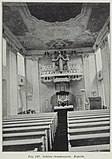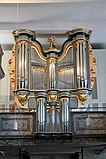Florentinus Wang
Florentinus Wang (* 17th century ; ⚰ February 20, 1742 ) was a German organ builder who worked in the Duchy of Nassau in the 18th century .
life and work
Little biographical details are known about Florentinus Wang. He came from Lützenburg (= Luxembourg ) and started his own workshop in Hadamar . In the years 1708 and 1713 he is proven as a godfather in Hadamer. His area of activity extended mainly to northern Nassau, but he also worked in the Landgraviate of Hessen-Darmstadt .
The five-part prospectus structure with two high round towers on the outside, more rarely pointed towers, is characteristic. Two inward sloping harp fields or two high rectangular flat fields convey a low round tower in the middle. A cornice connects the round towers. The towers stand on consoles that are decorated with tendrils. Alternatively, the central round tower is elevated with two flat fields sloping outwards. Wang built single-manual organs without a separate pedal; only in Dillenburg was there a free pedal. With some organs the missing pedal work is absorbed by the gravity of a 16 ′ in the manual work. Alternatively or as a support, a fifth 6 'is used, which together with an 8' generates an acoustic 16 '. In the manual there are often a third next to a mostly five-fold cornett and a reed register .
Wang's pupil became Andreas Scheld, who worked from Niederscheld in the first half of the 18th century . Wang was buried in Hadamer on February 20, 1742.
List of works
Italics indicate that the organ has not been preserved or only the historical case has been preserved. In the fifth column, the Roman numeral indicates the number of manuals , a capital "P" indicates an independent pedal , a lower-case "p" indicates an attached pedal. The Arabic number indicates the number of sounding registers . The last column provides information on the state of preservation or special features. Italic letters indicate that the organ has not been preserved or only the prospectus has been preserved.
| year | place | church | image | Manuals | register | Remarks |
|---|---|---|---|---|---|---|
| 1698-1701 | Hattenrod | Protestant church | Attribution of new building; not received | |||
| 1703 | Ettingshausen | Protestant church | I. | 8th | Attribution of new building; Replaced in 1878 | |
| 1703 | Grünberg | City Church | I / p | 12 | New building; Transferred to the hospital church in 1812 and not preserved | |
| 1710 | Diez | St. Peter | I. | Installation of a used organ; not received | ||
| 1715-1716 | Diez | Oranienstein Castle , chapel | I / p | New building; Replaced by Wilhelm Sauer in 1935; Housing received | ||
| 1719 | Dillenburg | Evangelical town church | I / P | 13 | New building; Prospectus received | |
| 1722 | Kirchähr | St. Bartholomew and St. Sebastian | I. | Attribution of new building; not received | ||
| 1722 | Niederselters | St. Christopher | I. | Attribution of new building; not received | ||
| 1723 | Eppenrod | Ev. church | Attribution of new building; Housing received | |||
| 1723 | Flat | Ev. church | I. | 15th | Attribution of new building; Housing received | |
| 1725 | Schönbach | Ev. church | I. | Attribution of new building; Prospectus received | ||
| 1725 | Emmerichenhain | Ev. church | I. | 11 | New building; Housing and register partially preserved | |
| 1726-1727 | Daaden | Protestant church | I / p | 15th | New building; Replaced in 1908; Housing preserved (very similar to Haigar) | |
| 1732 | Haiger | Ev. church | I / p | 14th | 1730 new building contract; Housing and register partially preserved | |
| 1749? | Stone bridges | Evangelical chapel |

|
I. | 5 | New building, clearly assigned to Wang, originally for the Huguenot Church (Usingen) , 1908 to Merkenbach, 1951 Herborn psychiatry, Herborn town church at the end of 1980, stone bridges since 2013; largely preserved |
| ? | Driedorf | Ev. church | New building; Burned in 1819 | |||
| ? | Wins | Lower castle , court chapel | Assumption of new building, disposition like Oranienstein; not received |
literature
- Christian Binz: The Wang organ in the chapel of Oranienstein Palace in Diez. In: Nassau Annals. Vol. 125, 2014, pp. 137–151.
- Franz Bösken : Sources and research on the organ history of the Middle Rhine (= contributions to the Middle Rhine music history . Volume 7.1 ). tape 2 : The area of the former administrative district of Wiesbaden. Part 1: A-K . Schott, Mainz 1975, ISBN 3-7957-1307-2 .
- Franz Bösken: Sources and research on the organ history of the Middle Rhine (= contributions to the Middle Rhine music history . Volume 7.2 ). tape 2 : The area of the former administrative district of Wiesbaden. Part 2: L-Z . Schott, Mainz 1975, ISBN 3-7957-1370-6 .
- Franz Bösken, Hermann Fischer : Sources and research on the organ history of the Middle Rhine (= contributions to the Middle Rhine music history . Volume 29.1 ). tape 3 : Former province of Upper Hesse. Part 1: A-L . Schott, Mainz 1988, ISBN 3-7957-1330-7 .
- Franz Bösken, Hermann Fischer: Sources and research on the organ history of the Middle Rhine (= contributions to the Middle Rhine music history . Volume 29.2 ). tape 3 : Former province of Upper Hesse. Part 2: M-Z . Schott, Mainz 1988, ISBN 3-7957-1331-5 .
- Hermann Fischer, Theodor Wohnhaas: Lexicon of southern German organ builders . Florian Noetzel Verlag, Wilhelmshaven 1994, ISBN 3-7959-0598-2 , p. 448 .
- Hubert-Gabriel Hammer: Organ building in the Westerwald. Studies on organ building in the Rhineland. A. Volk, Cologne 1971.
- Rudolf Vierhaus (Ed.): German Biographical Encyclopedia . Vol. 10. 2nd edition. KG Saur, Munich 2008, ISBN 3-598-23160-1 , p. 406.
Individual evidence
- ↑ a b Organ in Hadamer , accessed on July 4, 2020 (PDF).
- ^ Bösken: Sources and research on the organ history of the Middle Rhine. Volume 2/1. 1975, p. 408.
- ^ Binz: The Wang organ in the chapel of Oranienstein Castle in Diez. 2014, pp. 148–149.
- ^ Fischer, Wohnhaas: Lexicon of south German organ builders. 1994, p. 448.
- ↑ a b Bösken: Sources and research on the organ history of the Middle Rhine. Volume 2/1. 1975, p. 165.
- ^ Bösken, Fischer: Sources and research on the organ history of the Middle Rhine. Volume 3/1, 1988, p. 293.
- ^ Bösken, Fischer: Sources and research on the organ history of the Middle Rhine. Volume 3/1, 1988, pp. 424, 427.
- ^ Binz: The Wang organ in the chapel of Oranienstein Castle in Diez. 2014, p. 146.
- ^ Binz: The Wang organ in the chapel of Oranienstein Castle in Diez. 2014, pp. 141–143.
- ^ Bösken: Sources and research on the organ history of the Middle Rhine. Volume 2/1. 1975, pp. 129-132.
- ^ Bösken: Sources and research on the organ history of the Middle Rhine. Volume 2/1. 1975, p. 512.
- ^ Bösken: Sources and research on the organ history of the Middle Rhine. Volume 2/1. 1975, p. 186.
- ^ Matthias Thömmes: Organs in Rhineland-Palatinate and Saarland . Paulinus, Trier 1981, ISBN 3-7902-0137-5 , p. 281 .
- ^ Hammer: Organ building in the Westerwald. 1971, p. 63.
- ^ Organ in Haiger , accessed on July 7, 2020.
- ^ Organ in Steinbrücken , accessed on June 17, 2020.
- ^ Bösken: Sources and research on the organ history of the Middle Rhine. Volume 2/1. 1975, p. 140.
- ^ Gabriel Isenberg: Organ landscape in transition. The history of the organs in the South Westphalian districts of Olpe and Siegen-Wittgenstein between 1800 and 1945. A contribution to the organ history of Westphalia . University of Music Carl Maria von Weber, Dresden 2017, p. 222 , urn : nbn: de: bsz: 14-qucosa2-167184 (dissertation).
| personal data | |
|---|---|
| SURNAME | Wang, Florentinus |
| ALTERNATIVE NAMES | Wang, Florence; Wangh, Florentinus |
| BRIEF DESCRIPTION | German organ builder |
| DATE OF BIRTH | 17th century |
| DATE OF DEATH | buried February 20, 1742 |
| Place of death | Hadamer |

